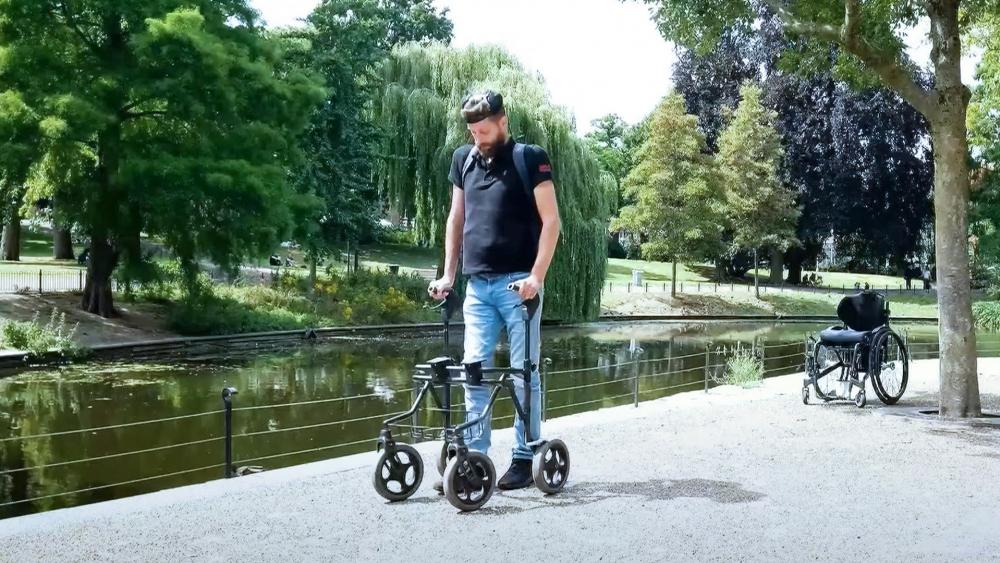A ground-breaking type of medical implant has helped one paralyzed man walk again. But what's most amazing is the fact that he had been disabled for more than 12 years after a spinal cord injury.
Dr. Grégoire Courtine and 33 of his colleagues from the Swiss Federal Institute of Technology in Lausanne detailed their research Wednesday in an article published in the journal Nature.
The researchers developed and implanted a "brain-spinal interface" (BSI) that forms a neurological link using a wireless digital bridge between the spinal cord and the brain of the individual.
Implants in the brain track intentions for movement, which are wirelessly transferred to a processing unit that a person wears externally, like a backpack. The intentions are translated into commands that the processing unit sends back through the second implant to stimulate muscles, CNN reported.
According to the outlet, other studies have revealed that directed electrical pulses can stimulate areas of the legs for walking. But this new technology allows for better natural movement and the ability to adapt to changing terrain because it reconnects two regions of the central nervous system that were interrupted because of a spinal cord injury, the researchers noted.
 Gert-Jan Oskam, 40, a native of the Netherlands, was basically paralyzed from the neck down after a motorcycle accident that happened more than a dozen years ago. His trunk, arms, and both legs were affected. He had recovered some partial mobility, but not enough to support his own mobility without assistance during his everyday life.
Gert-Jan Oskam, 40, a native of the Netherlands, was basically paralyzed from the neck down after a motorcycle accident that happened more than a dozen years ago. His trunk, arms, and both legs were affected. He had recovered some partial mobility, but not enough to support his own mobility without assistance during his everyday life.
"My wish was to walk again, and I believed it was possible," Oskam told reporters during a press conference this week. "I tried many things before, and now I have to learn how to walk normal again, like natural, because this is how the system works," according to CNN.
Previous versions of the spinal cord stimulation that Oskam received have helped people stand and take steps, but only after first pushing a button to activate the device. The new system enables him to merely think about walking before he can do it, the outlet reported.
Oskam told journalists he can walk at least 100 meters (roughly the length of a football field), depending on the day, and can stand without using his hands for a few minutes. Even with the BSI switched off, he has regained the ability to walk with crutches, signaling that his spinal cord may be only partially damaged and not completely severed.
He said it's useful in his daily life, like when he recently discovered he needed to paint something in his home but had no one to help, so he stood up and did it himself.
"It was quite science fiction at the very beginning, but it became true today," Dr. Jocelyne Bloch, co-leader and a neurosurgeon at the University of Lausanne in Switzerland, told the press conference.
And the implant's reliability has also been tested. Oskam's BSI link has been reliable for more than a year, according to the study.
Dr. Andrew Jackson, a neuroscientist at Newcastle University who was not involved in the study, told The New York Times: "It raises interesting questions about autonomy and the source of commands. You're continuing to blur the philosophical boundary between what's the brain and what's the technology."
Jackson told the newspaper that scientists in the field had been theorizing about connecting the brain to spinal cord stimulators for decades, but that this represented the first time they had achieved such success in a human patient.
"It's easy to say. It's much more difficult to do," he said.
At present, Oskam is the only person whose results with the stimulators are published. Researchers hope they will eventually help many more spinal cord injury and stroke patients get up out of wheelchairs. Standing also helps improve functions like bladder control, blood pressure, and sweating, according to USA Today.
These patients will have a natural-looking gait when they walk. It will not appear to be robotic as other stimulated walking has been, the researchers said.
**Please sign up for CBN Newsletters and download the CBN News app to ensure you keep receiving the latest news.**
Did you know?
God is everywhere—even in the news. That’s why we view every news story through the lens of faith. We are committed to delivering quality independent Christian journalism you can trust. But it takes a lot of hard work, time, and money to do what we do. Help us continue to be a voice for truth in the media by supporting CBN News for as little as $1.










 Subscribe
Subscribe Follow
Follow CBN.com
CBN.com
 Support CBN News
Support CBN News







